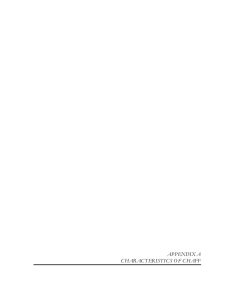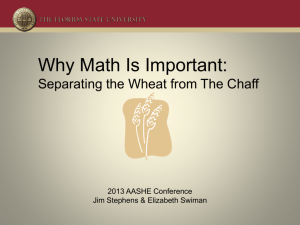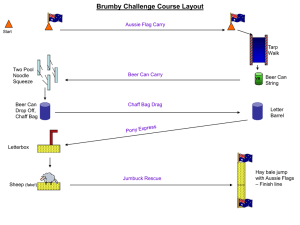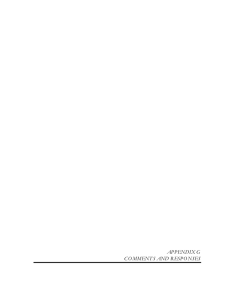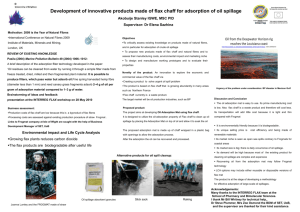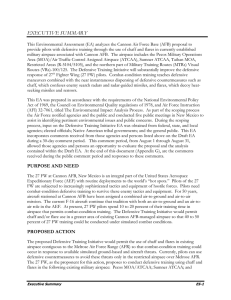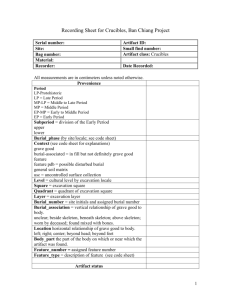GAO ENVIRONMENTAL PROTECTION DOD Management
advertisement
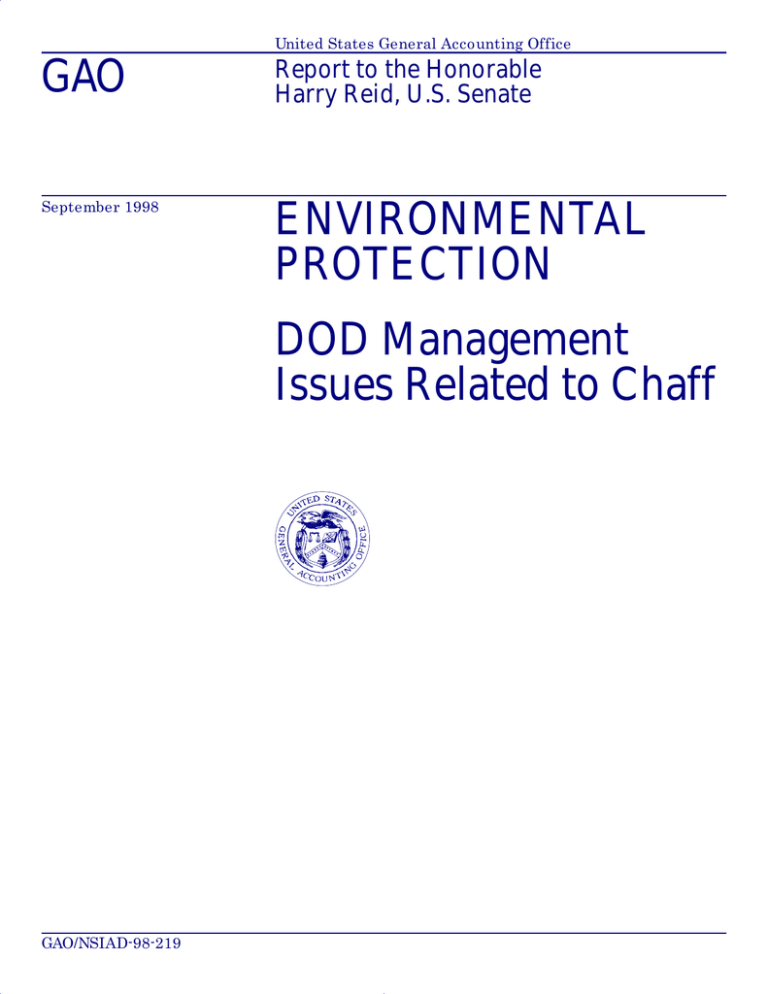
United States General Accounting Office GAO Report to the Honorable Harry Reid, U.S. Senate September 1998 ENVIRONMENTAL PROTECTION DOD Management Issues Related to Chaff GAO/NSIAD-98-219 GAO United States General Accounting Office Washington, D.C. 20548 National Security and International Affairs Division B-279055 September 22, 1998 The Honorable Harry Reid United States Senate Dear Senator Reid: This report responds to your request regarding the use of chaff by the Department of Defense (DOD) and the effects of chaff. Chaff is composed of aluminum-coated silica glass fibers that can be spread by aircraft in flight, ships at sea, and vehicles on the ground to help them evade enemy radar. You expressed concern about DOD’s continued use of chaff for decades without sufficient knowledge of its long-term effects on the environment. As agreed with your office, this report addresses (1) the extent and locations of chaff use, (2) its reported known and potential effects, and (3) the initiatives being taken or considered to address chaff’s unintended effects. Background Chaff works like a decoy by presenting a false target to enemy radar systems. It has been used by the military for more than 50 years. It was used during World War II and more recently during Operation Desert Storm. Chaff is also used in the peacetime training and testing of weapons. Chaff may be dispersed in bundles weighing from a few ounces to 24 pounds or from rolls in a continuous stream of over 30 pounds per minute.1 DOD updated controls over the use of chaff in an October 1997 interim draft of section 3212.02 of the Chairman of the Joint Chiefs of Staff manual. The manual sets the procedures for controlling the types of chaff to be used, the areas where it can be used, and altitudes at which it can be released. Each military facility has the authority to set local procedures that govern the use of chaff at training ranges and other locations near the facility. Concern about the potential effects of chaff continues to be an issue and has been expressed mainly by citizens and various public interest groups. In addition, some DOD research on the effects of chaff has expressed concerns and recommended further research. Most of the public concerns center around its effects on human health and the environment, including 1 A bundle is any precut chaff load in containers such as plastic tubes or cardboard boxes. Chaff rolls consist of either about 3,000 continuous strands that are dispensed by a cutter or of precut fibers placed between mylar sheets that are dispensed when the sheets are separated. Page 1 GAO/NSIAD-98-219 Chaff Management Issues B-279055 the potential for chaff particles to be inhaled or ingested and chaff’s effects on land, water, plants, and animals. Results in Brief Chaff is used worldwide in conjunction with military training, testing, and other assigned missions. In fiscal year 1997, the Air Force reported using about 1.8 million bundles worldwide, Navy and Marine Corps aircraft used more than 354,000 bundles and 593 rolls, and Navy combat ships used about 10,000 large bundles. DOD records indicate that fiscal year 1998 inventories include more than 37 million bundles and more than 141,000 rolls of chaff. The Air Force holds about 77 percent of the bundles, while the Navy and the Marine Corps hold all the rolls. The Army has some mission needs but possesses and uses little chaff in peacetime training or testing. While DOD components report that chaff is an effective means of defense for aircraft, ships, and related weapon systems, DOD and other agencies have identified some unintended and potential side effects of chaff. Chaff can affect safety by interfering with air traffic control radar. Chaff can also affect weather radar observations and the operation of friendly radar systems, especially when vehicles stir up chaff that has settled on the ground. It has been reported that chaff has also caused power outages and damaged electrical equipment. Potential effects cited by Defense and other organizations include those on health and the environment. For example, the Air Force reported that chaff has a potential but remote chance of collecting in reservoirs and causing chemical changes that may affect water and the species that use it. The services have a number of ongoing initiatives to address concerns about the unintended and potential effects of chaff. For example, DOD has entered into or is negotiating agreements with other federal agencies to address issues related to commercial air safety, weather forecasting, and environmental impacts on public lands. Also, the Navy has started a program to develop degradable chaff that is estimated to cost about 40 percent more than the current chaff. While intended as beneficial, the Navy has not yet defined the operational and environmental benefits that could result from this program. Notwithstanding DOD’s actions, some concerns continue to be raised by the public and federal agencies about the potentially harmful or undesirable effects of chaff on the environment. Also, some of DOD’s studies cite additional areas where questions have been raised about the unintended Page 2 GAO/NSIAD-98-219 Chaff Management Issues B-279055 effects of chaff. DOD has not systematically followed up on these questions or on the recommendations in these reports to determine whether they merit additional review. Lastly, DOD continues to retain lead-based chaff in its inventory even though this type of chaff has not been manufactured since 1987 and is reportedly no longer in use. Extent and Location of Chaff Use The first recorded large-scale use of chaff by American forces in combat was on December 20, 1943, in an air raid by 8th Air Force bombers over Bremen, Germany. Today, the services use chaff on combat ranges and at other locations worldwide for peacetime training and testing. Aluminum, because of its electrical conductivity,2 low cost, low weight, and durability, has been a consistent ingredient in chaff. In the 1980s, the cost of chaff was further reduced by replacing solid aluminum with hair-like silica glass fibers with a thin aluminum coating. Chaff was once produced using lead, and the Air Force still has some chaff containing lead in its inventory. According to the manufacturer, chaff containing lead was last manufactured in 1987.3 The proportion of lead in chaff dropped from about 1.2 ounces (7.5 percent) per pound in the 1950s to 0.16 ounces (1 percent) by 1987. The Air Force, the Navy, and the Marine Corps are the leading users of chaff. Air Force records indicate they used nearly 2 million 6- to 7-ounce bundles worldwide in fiscal year 1996 and about 1.8 million bundles in fiscal year 1997. Navy and Marine Corps aircraft together expended more than 340,000 and 354,000 similarly sized bundles in fiscal years 1996 and 1997, respectively. They also reported using 158 rolls in fiscal year 1996 and 593 rolls in fiscal year 1997. The Army currently uses very little chaff but has the capability to use it from some of its helicopters. The Army used a total of only 2,700 bundles of chaff from fiscal year 1991 to 1997. Army officials reported they plan to increase training with chaff and are developing chaff and dispensing equipment to be used on land-based vehicles. (See app. I for the various types of chaff used and app. II for data on reported chaff use by service and by selected location.) 2 Electrical conductivity is important because chaff absorbs and reflects electromagnetic energy to create a radar echo. 3 Only one U.S. manufacturer supplies chaff to the military. However, at least one additional manufacturer performs research and development into chaff materials. According to DOD, chaff with lead was last produced in 1983. Page 3 GAO/NSIAD-98-219 Chaff Management Issues B-279055 The services use chaff on training ranges around the world. The Air Force uses about 39 ranges in the United States and off its coast; the Navy and the Marine Corps use 14 ranges. The Air Force uses 14 ranges in 1 African and 7 European countries and 2 ranges in Korea, while the Navy and the Marine Corps have 1 range in Italy. According to Army officials, the Army does not use chaff on any of its ranges, but the other services do. For example, the Air Force uses chaff at White Sands Missile Range, and the Navy uses Dugway Proving Grounds for Navy ship chaff acceptance testing. Navy ships train with chaff in most of the world’s international waters. Navy officials stated that naval ships perform chaff tests and evaluations at two ranges off the U.S. east and west coasts. Figure 1 shows the states and offshore locations near the United States where chaff is used. Figure 1: States (shaded) and Off-shore Ranges Where Chaff Is Used Denotes off-shore ranges Page 4 GAO/NSIAD-98-219 Chaff Management Issues B-279055 The methods used to disperse chaff have evolved over the years, from simply tossing it out of airplane windows to launching it with spring-loaded or pneumatic machines. Currently, the services use pyrotechnic charges, rockets, mortars, air flows, or motors to disperse chaff. Many aircraft employ pyrotechnic charges that eject chaff in bursts from small bundles weighing about 6 ounces, while others use air flows to disperse ejected chaff. The Navy uses small rockets to launch airborne charges containing 8.5 pounds of chaff and shipborne charges containing 16.8 pounds of chaff. Navy ships can also launch mortar-like charges of chaff weighing between 16 and 24 pounds. Motors feed chaff from rolls of about 40 pounds through cutters4 carried on some aircraft to produce either bursts or a continuous stream. The continuous stream technique, called saturation chaff, may be used by aircraft to cover a large area. By 2005 or 2006, the Army also plans to use saturation chaff to mask vehicle and troop movements. Using a cutter, 360 pounds of chaff from nine 40-pound rolls can be deployed in 10 minutes. Depending on the method and the number of aircraft, such releases could disperse billions of fibers. The B-52 can carry about 750 seven-ounce boxes of chaff; each box contains up to 11 million fibers that can be expelled continuously or in bursts. Most chaff bundles contain millions of fibers. For example, the chaff bundles used most by the Air Force (RR-188) and the Navy (RR-144) contain more than 5 million individual fibers each, and the Navy’s Zuni rocket warhead (RR-182) contains more than 100 million fibers. Questions Continue to Be Raised Concerning Known and Potential Effects of Chaff Studies addressing the effects of chaff cite a number of known and potential effects. Furthermore, our discussions with officials from DOD, other federal agencies, and the private sector indicate that there are additional questions about the effects of chaff. Among these are the known effects of chaff on various types of radar and its potential effects on health and the environment. Air Force 1997 Report Summarizes Past Chaff Research Ten studies (see app. III) on the effects of chaff have been carried out over the past 45 years on request by the Army, Navy, Air Force, National Guard Bureau, and Canadian Forces Headquarters.5 An August 1997 report for 4 A cutter is used to cut a group of continuous strands of chaff to the desired length. 5 Although this was the only non-U.S. military sponsor, we chose to include it in our review because its report is a key animal study cited in many of the other studies we reviewed. Page 5 GAO/NSIAD-98-219 Chaff Management Issues B-279055 the U.S. Air Force Air Combat Command was the most recent and comprehensive review of the effects of chaff. The report includes original study as well as reviews of most of the previous reports. It cited the following categories that can be affected by the use of chaff: safety, air quality, physical resources (soil and water), biological resources, and land and cultural resources. Most known chaff effects fall into the safety category, while potential effects fall into the other categories. The following sections summarize the known and potential effects described in the Air Force report. Safety The report noted that while chaff is effective at confusing enemy radar, it also interferes with air traffic control radar. The report said that chaff had interfered at least twice with Federal Aviation Administration (FAA) radar but added that such events could be effectively avoided or managed. According to the report, safety risks from the use of chaff are extremely low and impacts on aircrews, aircraft, or the public are not anticipated. For example, the report found (1) no incidents of chaff interfering with satellite tracking; (2) two recorded incidents of military fighter aircraft interfering with FAA radar, but details were unavailable; (3) no documentation that chaff had caused aircraft radar systems to falsely identify nearby traffic; (4) no evidence of an aircraft engine failing after ingesting chaff; and (5) no reported accidents in which pilots were distracted by chaff. The report states that the primary safety concern is the potential for interference with FAA’s air traffic control radar but notes that DOD and FAA have agreed to restrict locations, altitudes, and times at which chaff can be used. The report states that a newer type of chaff that does not interfere with FAA radar is readily available. Air Quality Air quality issues addressed in the report include the potential for (1) noncompliance with national air quality standards due to the release of significant quantities of particulates, (2) release of hazardous air pollutant emissions, and (3) visibility impairment. The report takes into consideration the Clean Air Act6 and its amendments and includes a literature review of chaff dispersion and air quality effects as well as its own April 1994 technical report on chaff particulate testing. The report’s literature review shows that none of the previous studies had addressed the possible formation of inhalable particulates or issues related to compliance with the Clean Air Act. But the report indicates 6 The Clean Air Act requires the Environmental Protection Agency to set national air quality standards. Page 6 GAO/NSIAD-98-219 Chaff Management Issues B-279055 some inconsistencies in the reported size, use, and manufacture of chaff. The report cited a particulate test showing that potential effects would not exceed air quality standards, even though explosive charges on impulse cartridges may result in minimal releases of particulates. The report says that further study may be needed on the potential for short-term visibility impairment near training areas where large quantities of chaff are used. However, it says that chaff dispersed over a wide area and settled quickly in particulate testing. Its conclusions assume chaff containing lead is no longer being used. According to DOD, there have been no reports of short-term visibility impairments caused by chaff. Soil and Water The report says that the chemical or physical effects of chaff on soil and water would be very limited because chaff falls only in small quantities in any one location. It cites potential effects on wildlife through ingestion, inhalation, or skin contact; on species, habitat conditions, and aesthetics through settling in the water; and on water quality. The report includes a literature review, a laboratory analysis, and field studies at two locations where chaff is frequently used. One location is arid desert (Nellis Range Complex, Nevada) and the other humid woodlands (Townsend Air to Ground Gunnery Range, Georgia). The report notes that the literature addressing the effects of chaff on water quality and aquatic habitats is limited and that there has been no systematic analysis of chemical changes in soils exposed to various concentrations of chaff. It cites a 1977 Navy report that found no increase in aluminum or trace metals from chaff placed in water. The Air Force report notes that chaff’s potential to adversely affect the environment depends on the quantity deposited in a particular area, the fibers’ stability, the specific conditions of the soil and water, and the sensitivity of the environment to contaminants. It states that the likelihood of chaff falling into a particular pond, stream, or estuary in sufficient quantity to measurably affect the water’s chemical makeup is remote. Biological Resources The report addresses the potential biological effects of chaff on wildlife due to inhalation, ingestion, and direct contact as well as the effects of chaff on vegetation and aquatic life of chaff decomposing in soil or water. The Air Force reported no adverse impacts from chaff and said that chaff is generally nontoxic. However, few studies of the effects of chaff on wildlife have been conducted, and the report found no data on chaff’s decomposition process under different environmental conditions (arid, alkaline, wet, acidic) or inside the digestive systems of animals. The study includes a literature review, field studies, and laboratory analyses of soil Page 7 GAO/NSIAD-98-219 Chaff Management Issues B-279055 samples taken at Nellis and Townsend, the two military range areas studied. The report cites a 1972 Canada Department of Agriculture study that found no health hazards to farm animals. The Air Force study also cited a previous report on the Chesapeake Bay ecosystem that found no impacts on the six marine organisms studied.7 The Air Force study reports the following: • • • • • • Land and Cultural Resources Animals can inhale chaff particles, but the particles do not penetrate far into the respiratory system and can be easily cleared out. Chaff disperses over a large area of land, limiting exposure of grazing animals. Little chaff accumulated on the surface of standing water bodies. Surface-feeding or bottom-feeding animals and fish may ingest chaff, but this only affects a few individual animals and has a low impact on species populations except in the case of protected species. The numbers of chaff particles are negligible because chaff disperses over a large land area. Low concentrations of chaff limit the likelihood that birds would use chaff for nests and expose the young. Chaff disintegrates on land. It decomposes slowly in arid areas and has no adverse effects on soil chemistry and plant growth. Chaff interference with wildlife is expected to be negligible based on chaff use, characteristics, and observed accumulations. Chaff decomposing in water has no adverse impacts on water chemistry and aquatic life. In wet areas, chaff is covered by plant growth and dead leaves. Chaff decomposes more rapidly in wet acidic environments, but when doing so it releases only minute amounts of chemicals. Lead has not been used in the manufacture of chaff since 1983.8 Land resource issues addressed in the report concerned the accumulation of chaff and its potential to alter the land’s use and visual quality, while cultural resource issues related to the potential for physical or chemical impacts to alter the aesthetic setting and cultural context. The Air Force reviewed applicable laws and other related information and produced the field studies’ technical report. It did not identify any studies that assessed the impacts of chaff on either land use or its visual quality, or on cultural resources. Nevertheless, according to the Air Force, while chaff debris may be perceived as annoying or intrusive, it does not accumulate in quantities likely to have such impacts. The report states that, overall, chaff 7 Two universities, working with the prime contractor, reported effects on some of the Chesapeake Bay organisms studied, but the prime contractor concluded these effects were not significant and reported no short- or long-term adverse environmental effects in its summary (see app. III). 8 The manufacturer’s representative told us the business had last manufactured chaff with lead in 1987. As discussed in this report, chaff with lead was still in Air Force inventories at the time of our review. Page 8 GAO/NSIAD-98-219 Chaff Management Issues B-279055 debris has low visibility and little effect on the aesthetic quality of the environment. While noting that little data existed, the study reports that common nondestructive materials such as chaff have little potential for effects. The Air Force report states that the primary potential is for chaff debris to affect the aesthetic setting but that cultural resources are not generally located beneath airspace where heavy chaff use is concentrated and examinations could be done on a site-specific basis. It noted that no research exists on Native American concerns about the aesthetic effects of chaff deposits. Other Known Chaff Effects Our discussions with officials from federal agencies and the private sector brought out other known effects that are discussed in the following three sections. Effects on Weather Chaff can show up on radar as a false weather phenomenon and may affect lightning within storms. The National Weather Service (NWS) began to observe the widespread and frequent use of chaff in the late 1980s, when it started using new and more sensitive weather radar. Radar observations show that chaff can spread over several hundreds of miles and stay in the air for up to a day. A scientist formerly with the National Oceanic and Atmospheric Administration (NOAA), who now performs weather research at the University of Oklahoma, estimated it would have taken more than 200 billion chaff particles to create a radar picture taken in Arizona in 1997. DOD officials stated that it is improbable that such a large chaff deployment occurred outside of combat and is unlikely to occur in any future DOD training events. Figure 2 shows a 1997 NWS weather radar image of chaff over Southern Arizona. NOAA also provided pictures taken since 1993 in many other parts of the country and showing radar images of chaff. Page 9 GAO/NSIAD-98-219 Chaff Management Issues B-279055 Figure 2: NWS Radar Image of Chaff Plumes Over Southern Arizona and Southwestern New Mexico on October 8, 1997. According to NOAA officials and scientists, chaff can be easily identified under clear skies, but it can give false readings under other weather conditions and can thus impair the ability to make accurate forecasts. Chaff may be interpreted as precipitation and in some cases could result in inaccurate warnings of severe weather. Chaff could therefore interfere with missions that rely on accurate weather forecasts. One NOAA technical report describes chaff’s interference with normal weather observation data in at least two space-shuttle launch attempts.9 9 Chaff Observations with WSR-88D: Examples and Operational Impacts, NOAA / NWS /Spaceflight Meteorology Group, Johnson Space Center (July 1, 1994). Page 10 GAO/NSIAD-98-219 Chaff Management Issues B-279055 NOAA scientists are also concerned that chaff may cause inaccurate weather data to be archived for long-term climate research studies. Meteorologists can usually correctly identify chaff on radar, but automated systems cannot now distinguish chaff from rainfall. The automated systems record chaff as precipitation and overstate the amount of rain archived in the database. Researchers may therefore get inaccurate results from their studies. NOAA scientists are also trying to determine whether chaff suppresses lightning because this may also make it more difficult to assess the weather accurately.10 Large storms will usually produce frequent lightning strikes to the ground, and there is a direct correlation between the severity of a storm and the number of such strikes. However, it has been observed that some large storms inside chaff clouds had little or no lightning. If chaff reduces lightning, it could cause forecasters to underestimate the severity of storms. NOAA scientists and a University of Oklahoma weather researcher said they would like to further study the effects of chaff on thunderstorms if they could obtain funding. DOD officials stated that the U.S. Forest Service has used chaff for a number of years to suppress lightning and prevent forest fires, and NOAA issued an environmental impact statement on lightning suppression in October 1972. DOD believes the findings of this project should be reviewed to determine the need for additional analysis of this recognized phenomenon prior to expending additional funds. Friendly Forces Radar Systems Just as it can confuse enemy and FAA radar and produce false precipitation echos on NWS radar, chaff can also affect other friendly radar systems and thus hinder military air traffic controllers’ and meteorologists’ support for missions and operations. It can also affect friendly warning and targeting systems. According to Army chaff program officials, chaff on the ground can be stirred up by vehicles and can thus interfere with friendly airborne radar systems. Although the Army stated this as an area of potential concern, we found little documentation of these potential effects. To help alleviate the problem, the Army is developing chaff that will reduce interference with friendly forces’ radar systems. It hopes to have this chaff in the inventory by 2005-06. Power Outages Chaff can disrupt electrical power and directly affect electrical equipment. San Diego Gas and Electric Company and Navy officials have identified two instances in which chaff caused power outages in 1985. In the first 10 Intense Convective Storms With Little or No Lightning Over Central Arizona: A Case of Inadvertent Weather Modification?, NOAA, Environmental Research Laboratories, National Severe Storms Laboratory (July 22, 1996). Page 11 GAO/NSIAD-98-219 Chaff Management Issues B-279055 case, chaff accidently blown over San Diego, California, during a Navy exercise 75 to 200 miles from the coast affected power to 65,000 customers and disrupted air traffic control. The Navy reimbursed the power company between $50,000 and $60,000 for damage. The second incident occurred 5 days later, again in San Diego, when a Navy jet inadvertently showered power lines with chaff on takeoff, causing interruptions in power service. Current DOD Initiatives and Related Chaff Management Issues In an effort to address the unintended effects of chaff, DOD and the services have ongoing initiatives related to air traffic control, chaff use on public lands, chaff effects on weather, and degradable chaff. However, the initiative to develop degradable chaff is not supported by an operational or environmental requirement. According to DOD, the need to develop degradable chaff is supported by its obligation to protect the environment and its sensitivity to concerns expressed by some members of the public over the use and degradability of chaff. Notwithstanding these actions, questions about the potential adverse effects of chaff on health and the environment continue to be raised by various public interest groups and some federal and state officials.11 DOD’s own studies discuss some of the same questions. Our work shows that DOD has not systematically followed up on the questions being raised to determine whether they merit any further action. Also, DOD continues to retain lead-based chaff in its inventory, even though it is reportedly no longer being used. DOD Initiatives for Civilian Air Traffic Control To address concerns that chaff interferes with civilian air traffic control radar, FAA and DOD components have agreed to restrict the use of chaff and now require military installations to obtain clearance when using chaff in training and testing. DOD components also use training chaff, which is designed not to interfere with FAA radar frequencies. FAA has established procedures for coordinating all DOD electronic countermeasure missions and issues annual clearance letters to military facilities that use chaff, outlining restrictions that include controls over what kind of chaff can be used, where it can be used, and the altitudes at which it can be released. The Air Force, the Navy, and the Army have coordinated electronic countermeasures with FAA under a multiservice instruction that was first issued in 1964. According to DOD officials, an interim draft section 3212.02 11 Public interest groups include the Rural Alliance for Military Accountability, People for the West, the Wilderness Society, Citizen Alert, and the Sierra Club. Federal officials include those at the Department of Interior’s Bureau of Land Management and Fish and Wildlife Service. State officials include those at Nevada’s Department of Environmental Protection. Page 12 GAO/NSIAD-98-219 Chaff Management Issues B-279055 of the Chairman of the Joint Chiefs of Staff manual replaced the multiservice instruction in October 1997 and is expected to be finalized in October 1998. In commenting on a draft of this report, DOD said it has voluntarily restricted chaff use over concerns about public safety. DOD Initiatives for Chaff Use on Public Lands Initiatives between DOD and Department of Interior agencies are helping to identify and minimize the effects of chaff on public lands. The Fish and Wildlife Service (FWS) and the Bureau of Land Management (BLM) have signed agreements with individual military services to control chaff use over wildlife refuges, Native Americans’ reservations, and public lands near military training grounds. Examples include agreements signed November 21, 1994, for the Cabeza Prieta National Wildlife Refuge near Luke Air Force Base, Arizona; signed December 22, 1997, for the Desert National Wildlife Refuge near Nellis Air Force Base, Nevada; and signed June 11, 1998, for the public lands near Mountain Home Air Force Base, Idaho. Many military installations have local procedures to restrict the use of chaff near environmentally sensitive areas or population centers. In 1997, BLM set up a committee composed of representatives from the military services and civilian agencies to explore, among other issues, establishing a policy on dropping chaff over public lands, where it may be considered litter. The Navy said it has entered into three limited agreements to restrict chaff use over wildlife refuges and public lands because of concern over possible impacts on sensitive species. DOD Initiatives for Chaff Effects on Weather and components of NOAA have recently begun to identify and address concerns that chaff interferes with weather radar data and forecasting. These initiatives have been aided by the placement of new weather radar monitors at major military range weather stations.12 DOD frequency managers must now alert range operations officials to halt high-altitude chaff drops within a specified distance from the Kennedy Space Center prior to scheduled space-shuttle launches. Since February 1998, the Navy and NWS have been conducting coordinated chaff drops to allow NWS radar to record known quantities, areas, and times of chaff use. They anticipate a preliminary report by September 1998. DOD NOAA officials suggested additional recommendations to address chaff’s effects on the weather, including improving NWS and DOD liaison and interaction, having DOD alert NWS of planned unusual chaff use, and having 12 In a cooperative effort with DOD and FAA, NWS has deployed a total of about 160 new weather surveillance radars. Page 13 GAO/NSIAD-98-219 Chaff Management Issues B-279055 DOD limiting chaff use when significant weather is reported over or near the ranges. NOAA officials stated that their computer programs could be modified to address chaff effects on current forecasting and data archiving systems but said these modifications would be costly. Navy’s Initiative for Degradable Chaff The Navy is developing a new type of chaff that will break up more quickly in the environment. It says the new chaff is needed to alleviate public concerns about the health and environmental effects of chaff, particularly the perceived threat that chaff can be inhaled. However, DOD has not demonstrated how it will address these public concerns. The new chaff is also more expensive. Some Navy program officials told us there is no operational or environmental requirement to develop a new type of chaff and that the Navy believes the chaff currently in use is not harmful to the environment or a threat to health or public safety. However, they acknowledged that fiberglass chaff persists in the environment and that some members of the public perceive chaff as environmentally harmful or undesirable. They are taking action to develop a new degradable chaff, saying they thus hope to head off any possible restrictions on chaff use that may result in reductions in military training. DOD officials stressed its obligation to protect the environment and DOD’s sensitivity to concerns expressed by some members of the public. It noted that the effort includes the development of environmentally degradable parts to replace plastic pieces presently used in systems that dispense chaff. Unlike fiberglass chaff, the new chaff’s base material and its aluminum coating can take a few weeks to a few months to break up, depending on conditions. Development of the new chaff began in September 1993, and total development costs are estimated at about $3.6 million. Navy officials anticipate the new chaff will be available beginning in fiscal year 2001 and expect to buy only degradable chaff in the future. They plan to buy about 474,000 bundles a year through fiscal year 2003. A Navy program official estimated that a bundle of the new chaff will cost about 40 percent more than it does currently. No Systematic Follow-Up on Open Questions Studies by DOD and others, including some carried out years ago, continue to create questions in the public’s mind about the health and environmental effects of chaff. Department records indicate that DOD has Page 14 GAO/NSIAD-98-219 Chaff Management Issues B-279055 not systematically followed up on these reports to determine the merits of any outstanding question or the costs and benefits of addressing them. While none of the studies we reviewed demonstrated significant operational or environmental effects of chaff, 9 of the 10 reports cited gaps in information on potential effects. Six of the nine made no recommendations but cited missing data, suggested additional studies or long-term monitoring, or cited possible long-term chronic effects. Three reports recommended additional studies covering chaff toxicity, long-term exposure, weathering, or other study areas. However, DOD has not reviewed the recommendations and information gaps cited in the reports in a comprehensive and systematic way to assess their merits for further actions. For example, the Army’s January 1992 report cites data gaps and recommends that the long-term risk and chronic exposure of inhaled fibers be evaluated. Specifically, it recommends • • • • • • • future research on the resuspension rates of uncoated and coated fibers; studies to establish the weathering rates and chemical fate of metal coatings in soils, fresh water, and marine waters; a comprehensive review of threshold metal toxicity values for humans, animals, and important fresh water and marine organisms; a series of experiments to evaluate the potential impacts of fibers; an examination of the respirability of fibrous particles in avian species; aquatic and marine studies to establish the potential impacts of fibers; and future research on the pathology of inhaled fibers. The second and third of the above recommendations were partially addressed in the Army’s September 1992 report. Two other reports also partially addressed the second recommendation.13 We found limited evidence of follow-up on the other five recommendations. The 1997 Air Force study and its technical reports also cite the need for data and further research, including long-term studies. Two of the three technical reports recommend further research. One suggests long-term studies to monitor chaff accumulation on water bodies in high-use areas and the effects on animals using those water bodies. Another states that consideration could be given to monitoring programs for highly sensitive environments subjected to repeated chaff releases and conducting bioassay tests to further assess the toxicity of chaff to aquatic organisms. The final report noted that in some cases it might be appropriate to 13 Technical Report No. 4, Field Studies, October 1994, and Technical Report No. 5, Laboratory Analysis of Chaff and Flare Materials, November 1994, from the 1997 Air Force report. Page 15 GAO/NSIAD-98-219 Chaff Management Issues B-279055 analyze the potential for impacts to highly sensitive aquatic habitats that support threatened and endangered species in areas underlying airspace where chaff is proposed for use. But it does not recommend any follow-up work. Open questions similar to those in these reports have been cited by public interest groups such as those identified earlier. In discussing these questions in May and June 1998, DOD and service officials stated that additional actions were warranted on items such as follow-ups to previous studies and chaff’s weather-related effects. These officials said they are meeting to develop strategies to address the use and effects of chaff. They said these strategies, which have yet to be defined, could include a systematic follow-up of key study findings and recommendations and screening environmental assessments and impact statements to ensure consistent citation of study results. They said efforts will need to be coordinated among DOD components and could include interim controls over chaff use in sensitive environments. Unneeded Lead-Based Chaff Inventories Are Being Retained During the course of our work, we noted that some lead-based chaff was still being held in DOD’s active inventory. Older productions of foil chaff contained lead and lead is known to be toxic and can result in a number of health problems. As a result, DOD stopped purchasing chaff with lead. The Air Force reported it does not expect to use any chaff containing lead and the 1997 Air Force report stated that it is highly unlikely that any chaff containing lead is still in use. However, we found that the Air Force still does have chaff containing lead in its inventory and has no plans to eliminate it. We were provided a sample of chaff containing lead at one of the Air Force bases we visited during our review. The sample we obtained was of an aluminum-foil type used primarily by B-52s. In addition, Air Force records show that it still has in its inventory almost 40,000 bundles of chaff containing lead. These records came from Air Force and Defense Logistics Agency central inventory control points. Conclusions DOD and the services have developed ongoing initiatives to address certain concerns raised by the military’s use of chaff. These initiatives include plans for increased liaison with agencies such as BLM, FWS, and NWS. Nevertheless, the public, DOD studies, and other federal agencies continue to raise questions about the potential adverse effects of chaff. DOD has not Page 16 GAO/NSIAD-98-219 Chaff Management Issues B-279055 systematically followed up to determine whether these questions merit further action. Further, the Navy has initiated a degradable chaff research and development program but has not yet completely analyzed the operational and environmental benefits it expects to achieve. Lastly, although lead-based chaff has not been produced since 1987 and is no longer reported used, it is still retained in DOD’s inventory. We recommend that the Secretary of Defense direct Recommendations • • • the Secretary of the Navy to study the costs and benefits of the degradable chaff program before making a production procurement decision; the Secretaries of the Army, the Navy, and the Air Force to determine the merits of open questions made in previous chaff reports and whether additional actions are needed to address them; and the Secretary of the Air Force to prepare a specific plan to ensure that chaff containing lead at inventory control points and military installations is located and eliminated. Agency Comments In written comments on a draft of this report, DOD concurred with our findings and recommendations. (See app. IV.) DOD stated that the Navy is developing information on the costs and benefits of degradable chaff for use in a procurement decision. It stated that the services will assess whether additional actions are needed to address open questions from previous chaff reports. DOD also said that any training chaff with lead would be eliminated and that operational chaff would be clearly marked so that it could only be used to meet combat requirements. DOD also provided technical comments which we incorporated where appropriate. Scope and Methodology To address the extent and location of DOD’s chaff use, the known and potential effects of chaff, and initiatives to mitigate these effects, we interviewed and obtained documents from officials at the Department of Defense, the military services, components of the National Oceanic and Atmospheric Administration (including the Office of Oceanic and Atmospheric Research and the National Weather Service), the Federal Aviation Administration, the Bureau of Land Management, the Fish and Wildlife Service, the Environmental Protection Agency, the Defense Logistics Agency, and the Federal Communications Commission. In addition, we spoke with state officials and other parties from the states of Nevada, Florida, Oklahoma, and Arizona, including Native Americans, Page 17 GAO/NSIAD-98-219 Chaff Management Issues B-279055 public interest groups, and interested citizens, to determine whether they had concerns about chaff use or were aware of any health or environmental effects. We also visited chaff manufacturers’ representatives to discuss the production of chaff and the development of degradable chaff. To obtain information on the extent and locations of chaff use, we performed work at the following military installations: Fallon Naval Air Station and Nellis Air Force Base, Nevada; Eglin Air Force Base, Florida; and Luke Air Force Base and Yuma Marine Corps Air Station, Arizona. These installations conduct operations using chaff as part of their electronic countermeasure training. At these locations we discussed the use of chaff, the studies that have been performed on chaff, and public perceptions about the use and effects of chaff from military operations. We reviewed environmental reports and research studies, environmental impact statements and assessments, and other related information dealing with the effects of chaff to determine the environmental effects of chaff that have been documented. Our review of these reports was limited to an analysis of their recommendations, issues, and questions they raised. We grouped these into generally related categories to assess the extent to which DOD actions related to the categories. We did not attempt to analyze the content of each report. We did note that many of these studies were carried out a number of years ago and that research records were not readily available. We conducted our review from December 1997 to July 1998 in accordance with generally accepted government auditing standards. Unless you publicly announce its contents earlier, we plan no further distribution of this report until 15 days after its issue date. At that time, we will make copies available to appropriate Senate and House committees; the Secretaries of Defense, the Army, the Navy, and the Air Force; the Commandant of the Marine Corps; and the Director, Defense Logistics Agency. Page 18 GAO/NSIAD-98-219 Chaff Management Issues B-279055 Please contact me on (202) 512-8412 if you or your staff have any questions concerning this report. Major contributors to this report are listed in appendix V. Sincerely, David R. Warren, Director Defense Management Issues Page 19 GAO/NSIAD-98-219 Chaff Management Issues Contents Letter 1 Appendix I Types of Chaff 22 Appendix II Services’ Use of Chaff During Fiscal Years 1991-97 23 Appendix III GAO-Reviewed Reports on Chaff Research 25 Appendix IV Comments From the Department of Defense 27 Appendix V Major Contributors to This Report 29 Tables Figures Table II.1: Air Force Chaff Used During Fiscal Years 1991-97 Table II.2: Navy Air-launched Chaff Used During Fiscal Years 1991-97 Table II.3: Navy Sea-launched Chaff Used During Fiscal Years 1991-97 Table II.4: Army Chaff Used During Fiscal Years 1991-97 Table II.5: Chaff Use Reported at Military Installations Reviewed Figure 1: States and Off-shore Ranges Where Chaff Is Used Page 20 23 23 24 24 24 4 GAO/NSIAD-98-219 Chaff Management Issues Contents Figure 2: NWS Radar Image of Chaff Plumes Over Southern Arizona and Southwestern New Mexico on October 8, 1997. 10 Abbreviations BLM DOD FAA FWS NOAA NWS Page 21 Bureau of Land Management Department of Defense Federal Aviation Administration Fish and Wildlife Service National Oceanic and Atmospheric Administration National Weather Service GAO/NSIAD-98-219 Chaff Management Issues Appendix I Types of Chaff Chaff type Service Weight Compositiona Inventoryb RR-170A/AL (operational) Air Force 6.4 oz. Fiber 23,606,750 RR-180/AL (operational) Air Force 6.4 oz. Fiber 830,786 RR-188/AL (training) Air Force 6.4 oz. Fiber 1,881,503 RR-112A/AL (B-52) Air Force 7.0 oz. Fiber 372,720 RR-136C/AL (RF-4) Air Force 14.4 oz. Fiber 939,990 RR-141E/AL (EF-111) Air Force 6.9 oz. Foil 207,557 RR-149/AL (B-52) Air Force 5.9 oz. Foil 1,440 RR-149A/AL (B-52) Air Force Unknown Fiber RR-72B/AL Air Force Unknown Foil RR-72C/AL Air Force Unknown Fiber RR-185/RR-ZZZ (B-52) Air Force Unknown Fiber 235,767 RR-129/AL (operational) Navyc 4.7 oz. Fiber Classified RR-144/AL (training) Navyc 4.8 oz. Fiber Classified RR-171/AL (roll) Navyc 41-43 lbs. Fiber Classified RR-179/AL (roll) c Navy 40 lbs. Fiber Classified RR-181/AL (AIRBOC-ship) Navyc 16 lbs. Fiber Classified c 412 37,800 210,360 RR-182/AL (Zuni rocket) Navy 8.5 lbs. Fiber Classified RR-184/AL (operational) Navyc 1.4 oz. Fiber Classified RR-189/AL (training) c Navy 1.4 oz. Fiber Classified MK-182 mod 1 Navyd 16 lbs. Fiber 4,841 MK-182 mod 2 d Navy 24 lbs. Fiber 4,909 MK-214 Navyd 24.3 lbs. Fiber 50,163 MK-216 Navyd 16.8 lbs. Fiber 24,118 M-1 Army 3.5 oz. Fiber 310,000 a Fiber: aluminum-coated silica glass fibers; foil: aluminum foil. b Air Force data as of May 8, 1998; Navy data as of March 3, 1998; and Army data as of February 23, 1998. c Launched from airplanes. d Dispensed from ships. Page 22 GAO/NSIAD-98-219 Chaff Management Issues Appendix II Services’ Use of Chaff During Fiscal Years 1991-97 Table II.1: Air Force Chaff Used During Fiscal Years 1991-97 (bundles) Fiscal year Chaff type RR-170A/AL 1991 1992 1993 1994 1995 1996 1997 1,361,216 1,689,200 1,545,715 1,412,244 1,415,496 834,827 826,669 RR-180/AL 0 0 530 0 0 0 4,565 RR-188/AL 0 103 7,105 166,447 1,285,876 1,153,439 950,655 RR-136C/AL 0 0 0 0 0 0 0 RR-141E/AL 0 0 0 0 0 0 0 RR-112A/ALa RR-149/ALa RR-149A/ALa RR-72B/ALa RR-72C/ALa RR-185 and RR-ZZZa a According to Air Force logistics officials, expenditure history for these chaff types is unknown. Table II.2: Navy Air-launched Chaff Used During Fiscal Years 1991-97 (bundles, unless otherwise indicated) Fiscal year Chaff type 1991 1992 1993 1994 1995 1996 1997 RR-129 343,117 436,219 277,665 243,219 339,087 233,662 107,469 RR-144 34,593 89,868 79,252 84,698 74,944 91,875 197,370 RR-171 (rolls) 641 179 199 115 58 47 26 RR-179 (rolls) 665 367 289 327 369 111 567 RR-181 171 189 166 148 88 279 217 RR-182 rocket 552 80 24 0 0 0 0 RR-184 0 0 0 0 352 6,637 39,712 RR-189 0 0 0 0 0 8,303 10,145 Page 23 GAO/NSIAD-98-219 Chaff Management Issues Appendix II Services’ Use of Chaff During Fiscal Years 1991-97 Table II.3: Navy Sea-launched Chaff Used During Fiscal Years 1991-97 (bundles) Fiscal year Chaff type 1991 1992 1993 1994 1995 1996 1997 MK-182 Mod 1 1,752 1,599 1,215 1,403 1,029 1,293 581 MK-182 Mod 2 733 661 1,218 806 263 373 175 MK-214 721 1,704 5,332 1,987 1,957 3,129 8,472 MK-216 186 453 619 574 1,232 1,214 1,026 Table II.4: Army Chaff Used During Fiscal Years 1991-97 (bundles) Fiscal year Chaff type 1991 1992 1993 1994 1995 1996 1997 0 50 0 1,251 1,161 118 120 M-1 Table II.5: Chaff Use Reported at Military Installations Reviewed (bundles) Fiscal year Installation Chaff type Nellis Air Force RR-170 Base (AFB), Nev. RR-188 1995 1996 1997 122,798 271,946 98,370 186,772 58,420 194,161 Eglin AFB, Fla. RR-170 RR-188 other 58,509 645 2,480 114,444 14,260 0 124,787 22,291 704 Luke AFB, Ariz. RR-170 RR-188 Not available Not available 12,667 162,053 Fallon Naval Air Station, Nev. RR-129 RR-144 35,610 12,480 55,469 36,660 0 13,212 Yuma Marine RR-129 Corps Air Station, RR-144 Ariz. Not available Not available 24,169 34,086 Page 24 GAO/NSIAD-98-219 Chaff Management Issues Appendix III GAO-Reviewed Reports on Chaff Research The reports we reviewed on chaff research were issued between 1952 and 1997. As shown below, all but one were sponsored by DOD components. Environmental Effects of Self-Protection Chaff and Flares, U.S. Air Force Air Combat Command (Aug. 1997).1 Aquatic Toxicity and Fate of Iron and Aluminum Coated Glass Fibers, U.S. Army Chemical Research, Development, and Engineering Center (Sept. 1992).2 Environmental and Health Effects Review for Obscurant Fibers/Filaments, prepared by the Pacific Northwest Laboratory for the U.S. Army Chemical Research, Development, and Engineering Center (Jan. 1992). Environmental Effects of Air National Guard Chaff Training Activities, prepared by Science and Engineering Associates, Inc., for the National Guard Bureau (Dec. 1990). Identifying and Evaluating the Effects of Dispensing Chaff From Military Aircraft, prepared by Science and Engineering Associates, Inc., for the Air Force Strategic Air Command (Dec. 5, 1989). Environmental Effects of Chaff, U.S. Air Force Occupational and Environmental Health Laboratory (Dec. 1978). Effects of Aluminized Fiberglass on Representative Chesapeake Bay Marine Organisms, prepared by Systems Consultants, Inc., for the U.S. Naval Research Laboratory (Nov. 23, 1977).3 The Ingestion of Fiberglass Chaff by Cattle, prepared by the Canada Department of Agriculture for the Director of Electronic Warfare, Canadian Forces Headquarters (Mar. 8, 1972). Chaff, Wright Air Development Center (May 1956). 1 Includes three technical reports on the effects of chaff dated April 1994, October 1994, and November 1994. Portions of the report, including two additional technical reports, address the effects of flares, which are not included in our scope. 2 We also reviewed the Army Report, Aquatic Toxicity and Fate of Nickel Coated Graphite Fibers, With Comparisons to Iron and Aluminum Coated Glass Fibers, U.S. Army Chemical and Biological Defense Agency (July 1993), but because it focused mainly on infrared obscurants rather than radar-evading chaff, we did not include it in our scope. 3 Systems Consultants, Inc., incorporated reports by two subcontractors, the University of Delaware and the University of Maryland. Page 25 GAO/NSIAD-98-219 Chaff Management Issues Appendix III GAO-Reviewed Reports on Chaff Research Toxicity of Chaff to Livestock, U. S. Air Force Aeromedicine Laboratory (1952). Page 26 GAO/NSIAD-98-219 Chaff Management Issues Appendix IV Comments From the Department of Defense Page 27 GAO/NSIAD-98-219 Chaff Management Issues Appendix IV Comments From the Department of Defense Page 28 GAO/NSIAD-98-219 Chaff Management Issues Appendix V Major Contributors to This Report National Security and International Affairs Division, Washington, D.C. Charles I. Patton, Jr. Uldis Adamsons Richard W. Meeks Los Angeles Field Office Lionel C. Cooper, Jr. Gary W. Kunkle Office of the General Counsel, Washington, D.C. Margaret L. Armen (709295) Page 29 GAO/NSIAD-98-219 Chaff Management Issues Ordering Information The first copy of each GAO report and testimony is free. Additional copies are $2 each. Orders should be sent to the following address, accompanied by a check or money order made out to the Superintendent of Documents, when necessary. VISA and MasterCard credit cards are accepted, also. Orders for 100 or more copies to be mailed to a single address are discounted 25 percent. Orders by mail: U.S. General Accounting Office P.O. Box 37050 Washington, DC 20013 or visit: Room 1100 700 4th St. NW (corner of 4th and G Sts. NW) U.S. General Accounting Office Washington, DC Orders may also be placed by calling (202) 512-6000 or by using fax number (202) 512-6061, or TDD (202) 512-2537. Each day, GAO issues a list of newly available reports and testimony. To receive facsimile copies of the daily list or any list from the past 30 days, please call (202) 512-6000 using a touchtone phone. A recorded menu will provide information on how to obtain these lists. For information on how to access GAO reports on the INTERNET, send an e-mail message with "info" in the body to: info@www.gao.gov or visit GAO’s World Wide Web Home Page at: http://www.gao.gov PRINTED ON RECYCLED PAPER United States General Accounting Office Washington, D.C. 20548-0001 Official Business Penalty for Private Use $300 Address Correction Requested Bulk Rate Postage & Fees Paid GAO Permit No. G100

